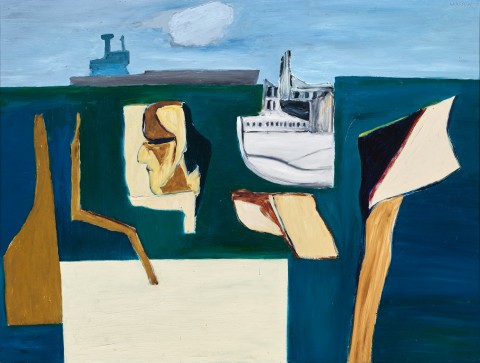FACE AND FLAG FACE OR DEEP DREAM, 1976
KEN WHISSON
oil on composition board
82.0 x 109.0 cm
signed, dated, and inscribed with title verso: “FACE AND FLAG FACE” / OR “DEEP DREAM” / PAINTED 24 / 3 / 76 / KEN WHISSON.
bears inscription verso: TITANIUM WHITE / TO RAY HUGHES … BRISBANE / “FACE AND FLAG – FACE”/ OR “DEEP DREAM” / 24 / 3 / 76
Ray Hughes Gallery, Brisbane
Ray Hughes, Sydney (bears label verso)
The Estate of Ray Hughes, Sydney
probably: Ray Hughes Gallery, Brisbane, 1976
Ken Whisson, As If, Heide Museum of Modern Art, Melbourne, 17 March – 15 July 2012; Museum of Contemporary Art, Sydney, 28 September – 25 November 2012, cat. 90
Barkley G., and Harding, L., Ken Whisson. As If. ,Heide Museum of Modern Art, Melbourne and Museum of Contemporary Art, Sydney, 2012, p. 154 (illus.)
There is an almost cult status around Ken Whisson and his work. To own a Whisson is to belong to a club which reflects collectors’ shared commitment to a form of painting that is not simply fashionable, but deeply seated in ideas and painterly possibilities. Born in Lilydale in 1927, Ken Whisson was part of a generation of artists that included Albert Tucker, Sidney Nolan, Arthur Boyd, and the European migrant Danila Vassilieff, who as his teacher, had a profound influence on the young artist.
Face and Flag Face or Deep Dream, 1976, belongs to a fascinating group of works created prior to Whisson’s departure from Australia for Italy in 1977, and is typical of his St Kilda period. As well as the current work, paintings of that time included Disembarkation at Cythera (Idiot Wind), 1976, held in the collection of National Gallery of Australia and What Should we Do When we Get to Illyria, 1974, which was notably owned by the artist, Rosalie Gascoigne.
From his flat in Acland Street, St Kilda, Whisson had a view of the maritime traffic coming and going from Port Melbourne, and consequently these works are all characterised by motifs of ships, clouds, figures and flags. Two ships feature prominently in Face and Flag Face or Deep Dream; one sits on the horizon beneath a soft grey cloud and a second ship appears to be turned toward the viewer. The latter abruptly breaks the horizon line in a manner that flattens the picture plane and disrupts the conventional idea of western pictorial perspective.
In Disembarkation at Cythera (Idiot Wind) Whisson depicts migrants arriving at Port Melbourne, commenting, “My people were more like poor Italian migrants who have come from a splendid, beautiful place to the awful environment of Port Melbourne … an industrial place.”1 Whisson was clearly sensitive to the experience of migrants coming to Australia from Europe with its centuries of painting, literature and architecture – a world to which he was about to permanently move – and arriving in a foreign country, carrying with them hopes and dreams of life in a new world.
In Face and Flag Face or Deep Dream, we have a similar arrangement, however here the artist has painted a clean, titanium white rectangle which dominates the foreground. Above and around it the forms appear to hover and float, as though trying to find their place, both in the new world in which they have arrived, and in the painting. The white area is suggestive of both a fresh beginning for the migrants as well as the artist’s blank surface. The notion of the flag face in the title perhaps speaks to the individual identity of migrants.
The current example is consigned from the Estate of the gallery owner Ray Hughes, who exhibited Ken Whisson’s work from 1973 onwards. Hughes’ long association with Whisson helped define his Gallery as one that took pride in representing artists who existed outside the fashionable mainstream of curatorial elites.
Whisson’s painting represents the antithesis of painterly conventions, he abandons any preconceived expectations, which frees his mind to expand onto the canvas. No matter how suggestive these interpretations are, it is of course all conjecture, Whisson’s works are complex personal images, which puzzle many and polarise opinion. In the end its all a matter of memory and which memories matter in the mind of the artist.
1. Blackman, B., Interview with the artist, 20 April 1984, National Library of Australia Oral History Program, tape 1:2
HENRY MULHOLLAND
